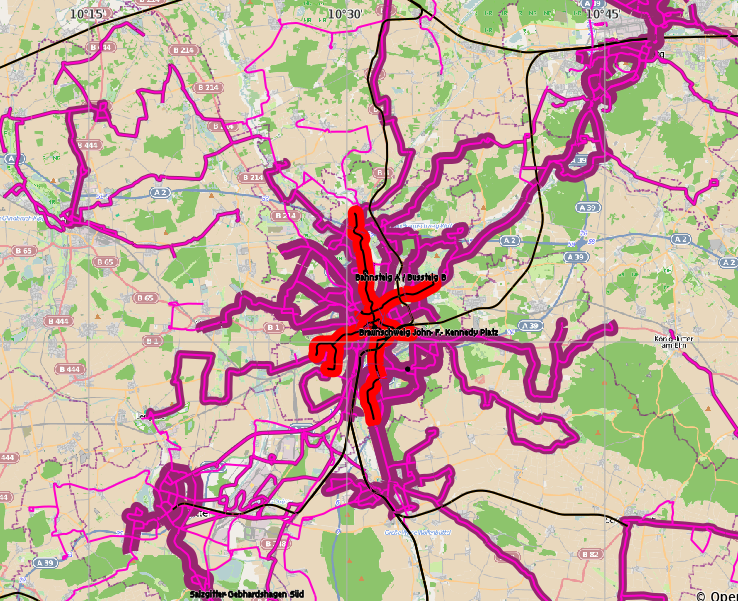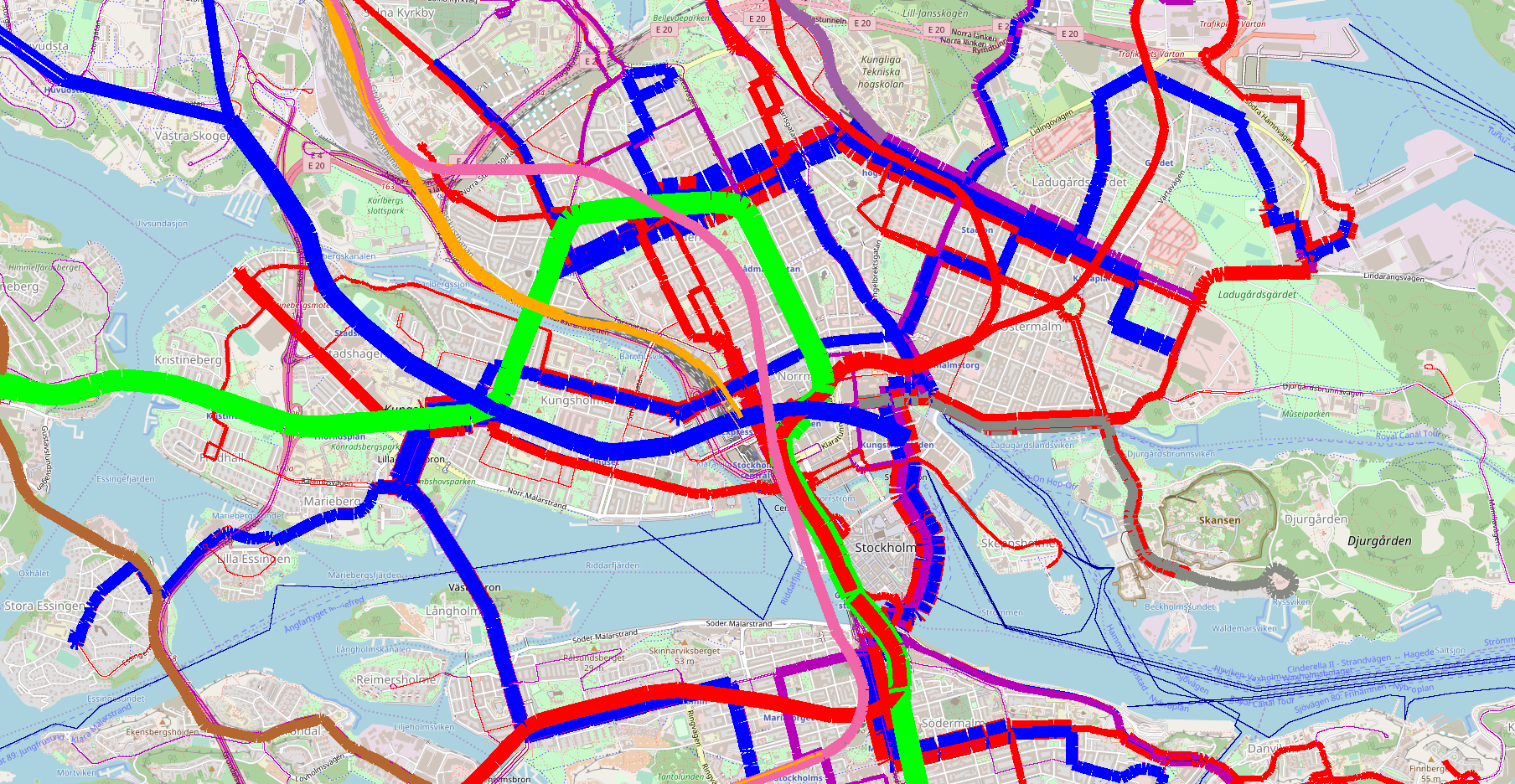Proposal:Interval
| This proposal dates from 2014 and is now rather old. Because it didn't came to a vote Leif Rasmussen has created a new proposal which was approved. So there is no need to move on with this proposal.
|
| Interval | |
|---|---|
| Proposal status: | Obsoleted (inactive) |
| Proposed by: | Vicuna |
| Tagging: | interval=10
|
| Applies to: | route |
| Definition: | Proposal to define the service quality of public transport routes |
| Statistics: |
|
| Draft started: | 2014-05-21 |
Why interval?
One of my aims is to get better information about public transport in OSM. With the growing numbers of bus routes included in the database it is getting difficult to extract important and "usable" routes. Some routes are only served once or twice a day, others hourly or every 20 minutes. Several proposals were discussed in various OSM Wiki pages (e.g. to classify whether it is a school bus or weekend line).
The interval tag is a very accurate information about the service quality of a public transport route. With this it is also possible to see differences between subway or tram systems and calculate operational data (together with route lengths etc.).
What is needed at least?
My proposal is to have at least the "interval"-tag for every route. If possible also other time slices could be added, e.g. "interval:evening" or "interval:sunday".
Isn't the service interval changing too often?
I don't think so. My experience of the last years is that bus routes change their served streets and stops more often than their basic interval. The interval tag is very simple to understand and not that complex as a complete timetable.
Which value should be used?
There are already some interval-tags in OSM and it seems to be the best to use minutes. Some users introduced an hour info "2:00", but for calculation reasons I propose to use only minutes (120). So it is possible to use the data with Maperitive. If you want to classify all routes going every 2 hours or more often then use the term interval<121.
Proposal for the timeslice of sub-tags
| 0 | 1 | 2 | 3 | 4 | 5 | 6 | 7 | 8 | 9 | 10 | 11 | 12 | 13 | 14 | 15 | 16 | 17 | 18 | 19 | 20 | 21 | 22 | 23 | Comment |
|---|---|---|---|---|---|---|---|---|---|---|---|---|---|---|---|---|---|---|---|---|---|---|---|---|
| interval | General tag which is valid, if there is no other sub-tag. | |||||||||||||||||||||||
| interval:peak | interval:peak | Use only, if there is a notable peak deviation. | ||||||||||||||||||||||
| interval:midday | Use only, if there is a short deviation around noon, otherwise use interval. | |||||||||||||||||||||||
| interval:evening | The evening also contains the late hours. | |||||||||||||||||||||||
| interval:night | The night starts at midnight. No tag = no service. | |||||||||||||||||||||||
Examples
| Example Set | Description |
| interval = 10
|
The route departs every 10 minutes. This "main" interval tag should always be used, though no exact time frame can be read out. It is easy to use and supports the introduction of this tag even if the detailed timetable is unknown. |
| interval = 10 interval:evening = 20 interval:sunday = 30 |
The route departs usually every 10 minutes, in the evenings only every 20 minutes and on sundays (and probably public holidays) every 30 minutes. The idea is to support lazy users: Thus it is not mentioned interval:weekend on Saturday daytimes there will be probably a 10-minute-interval. It is also not defined, which interval is running on weekend evenings is, but it will probably be 20 minutes on Saturday and 30 minutes on Sunday, because the evening interval won't be better than the daytime one. |
| interval = 10 interval:weekend = 20 |
The route departs every 10 minutes on weekdays and every 20 minutes on weekend days (and probably on public holidays). This tag is easier to use if both weekend days have the same service level. |
| interval = 120
|
The route departs every 2 hours. |
| interval = 10 interval:peak = 5 |
The route departs every 10 minutes, but in the peak times every 5 minutes. As the "main" interval is 10 minutes, the peak hour will only last a short time: Not more than two hours in the morning and three hours in the afternoon. Also here the amount of information should be limited. Users shouldn't be frightened by expectations to write about exact start end end times. |
| interval = 5 interval:midday = 10 |
This is the case if the previous example would be a little bit different: The "main" interval is 5 minutes, but there is a gap of a few hours around noon, when the route departs only every 10 minutes. |
| interval = 10 interval:night = 30 |
This could be a so called "metro" bus route in Berlin. The line departs ususally every 10 minutes. In the night it departs as night service every 30 minutes. As there is no info about the weekend, the route departs every 10 minutes also on sundays. |
| interval = 10 interval:evening = - |
Not mandatory: This is a particular info, that the route is not running in the evening. This will help to distinguish between different route variations within one route-master. It is not intended, to tag that every bus route on the country is not running in the evening or at night.
Perhaps it might be better to write none or no_service than to use a minus? |
| interval = -
interval:night = 30 |
This is a night service, which is not running during day time. The minus for the main-interval-tag indicates, that this line can't be used most of the time. |
| interval = school | The route is a school bus with two rides at school begin and end times. |
| interval = daily |
The route departs once a day. (This sounds positive. An alternative would be 1_per_day, which could have a more negative view about only one connection a day.) |
| interval = 2_per_day |
The route departs twice daily. Usually this is not every 12 hours, but e.g. in the morning and evening for commuters. The number in the beginning supports the automatic evaluation. It is easier to have an integer, than words. |
| interval = x_per_day |
x departures a day, not in a regular interval. This should only be used for low numbers. If there is a regular 4-hour-interval, interval = 240 should be used instead. |
| interval = weekly | The route departs once a week. |
| interval = x_per_week | The route departs x times a week. Replace x with the number of departures. |
| interval = at_least:120 | This route departs irregularly, but regular in a way, that it can be stated, that there is a departure at least every two hours. The usage of this value makes sense, if the interval is more often than three times daily. |
| interval = irregular | These are runs that belong to a regular-interval route, but they use a different path which is used not in a regular interval. |
More Info
Interesting public transport statistics on my user page: User:Vicuna
Rendering
Using Maperitive the following map was created showing the service intervals of bus (magenta) and tram (red) lines with the line thickness in and around Braunschweig (Germany):
Another rendering of the public transport in Central Stockholm done by an own rendering tool.

